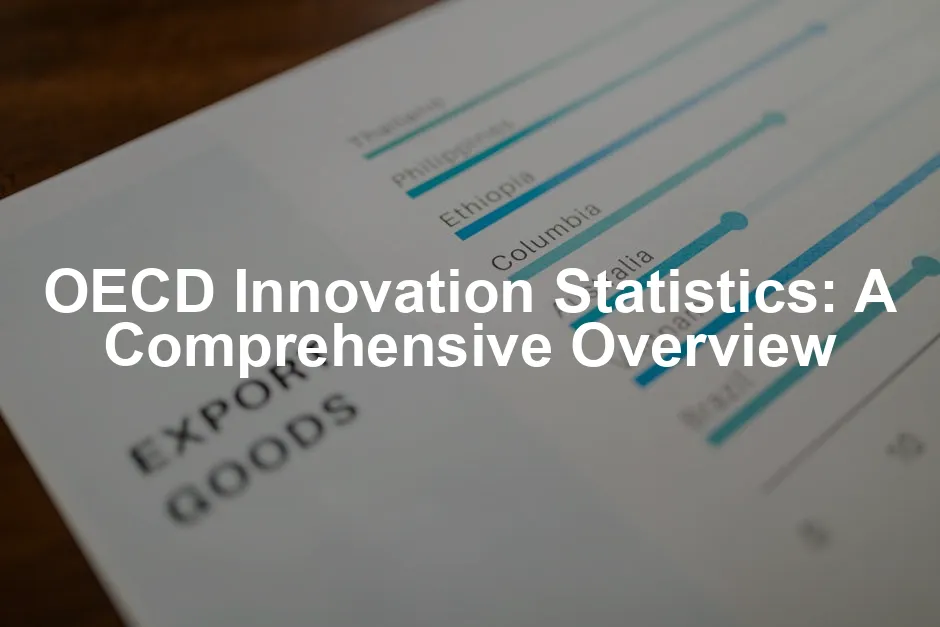Introduction
Innovation statistics hold immense significance in today’s global economy. They serve as a compass, guiding businesses and governments through the uncharted waters of technological advancement and economic growth. Without these statistics, navigating the complex world of innovation would be akin to sailing without a map—exciting but perilous!
Enter the Organisation for Economic Co-operation and Development (OECD). This international organization plays a crucial role in compiling and analyzing innovation data. The OECD provides a wealth of information that helps countries and organizations understand trends, identify gaps, and foster a culture of innovation. With its rigorous methodologies and comprehensive datasets, the OECD ensures that stakeholders have access to reliable information.
The purpose of this article is to take a closer look at OECD innovation statistics. We’ll explore what these statistics entail, their implications for policy-making, and how they can inform business practices. After all, understanding these numbers is essential for anyone looking to thrive in an increasingly competitive landscape. So, let’s embark on this enlightening journey through the world of OECD innovation statistics!

Understanding OECD Innovation Statistics
What Are OECD Innovation Statistics?
OECD innovation statistics encompass a broad range of indicators that provide a detailed picture of innovation activities and outcomes across member countries. These statistics are vital for both businesses and governments. For businesses, they highlight the extent to which new technologies, products, and processes are being developed and adopted. For governments, these statistics inform policy decisions that can foster a more innovative environment.
The OECD covers various innovation indicators, including research and development (R&D) expenditures, patent counts, and the adoption of new technologies. These indicators help paint a picture of how innovation is unfolding across different sectors and regions. This wealth of information is essential for understanding the innovation landscape and making informed decisions.
Speaking of understanding the innovation landscape, if you’re looking to dive deeper into the mechanics of innovation, you might want to check out The Oslo Manual: Guidelines for Collecting and Interpreting Innovation Data. This essential read provides the standards for collecting and interpreting data on innovation, ensuring you have the right tools to analyze your own data.

Importance of Innovation Statistics
Measuring innovation is not just a numbers game; it’s fundamental for economic growth and competitiveness. Countries that prioritize innovation tend to enjoy higher productivity levels, increased economic output, and improved quality of life. Innovation statistics provide valuable insights into how well a country is performing in this arena. They help identify leaders and laggards, allowing policymakers to formulate strategies that encourage growth and development.
Moreover, innovation statistics can guide policy-making by pinpointing areas that need support. For instance, if data shows a decline in R&D investment in a particular sector, governments can step in with targeted funding or incentives to revive it. This proactive approach ensures that innovation remains a key driver of economic success. By leveraging these statistics, nations can craft policies that not only respond to current challenges but also anticipate future needs.
In summary, understanding OECD innovation statistics is crucial for businesses and governments alike. They provide a roadmap for innovation, highlighting areas of strength and opportunities for growth. As we dive deeper into this topic, we’ll uncover how these statistics can shape policy decisions and influence business strategies in meaningful ways.
Key Components of OECD Innovation Statistics
Business Innovation Statistics and Indicators
The OECD Innovation Indicators database is like a treasure chest filled with insights. It showcases the innovation activities and outcomes of firms across OECD member countries and beyond. This extensive collection helps understand how well companies are integrating new products and improving their processes.
At the heart of this database lies the Oslo Manual. This manual serves as the guiding star for international surveys on business innovation. It establishes methodological standards for collecting and interpreting data. By adhering to these guidelines, the OECD ensures that the indicators derived from these surveys are both reliable and comparable across countries.
Key indicators in this database focus on various aspects of business innovation. Two crucial types are product innovations and process innovations. Product innovations refer to the development of new or significantly improved goods or services. Process innovations, on the other hand, involve changes in how products or services are created or delivered. Analyzing these indicators helps stakeholders gauge the innovation landscape effectively.
If you want to take your business innovation to the next level, consider reading Business Model Generation: A Handbook for Visionaries, Game Changers, and Challengers. This book equips you with the tools to create innovative business models that can help you adapt and thrive in any market.

The most recent data release, published in November 2023, offers fascinating insights. It covers business innovation activities from 2018 to 2020 across 42 economies, including many OECD and EU countries. This edition marks a significant milestone, as it introduces indicators reflecting innovations with environmental benefits. It’s encouraging to see that businesses demonstrated resilience during the initial stages of the COVID-19 crisis, continuing their innovation efforts despite the challenges.
Moreover, the November 2023 release emphasizes the importance of comparability. As more countries utilize standalone innovation surveys, the data collected under the Oslo Manual guidelines becomes increasingly reliable. However, the design and implementation of national surveys can still differ significantly. Factors such as question sequencing, target population, and data collection methods can influence results. This highlights the need for ongoing harmonization efforts to ensure that innovation statistics remain meaningful and actionable.
Research and Development Statistics
Research and Development (R&D) statistics provide a vital lens through which we can assess a country’s innovation capabilities. They represent the resources allocated to R&D activities across all OECD countries and select non-member economies. Understanding these statistics is crucial, as they inform policymakers about the investments driving innovation.
R&D expenditure trends reveal much about a country’s commitment to fostering innovation. Recent data shows that R&D investments have been increasing, with businesses leading the charge. In fact, businesses now account for nearly three-quarters of total R&D expenditure in the OECD area. This shift underscores the critical role that private sector investments play in driving innovation and economic growth.

Breaking down R&D resources by sector helps us understand where these investments are being directed. The statistics typically encompass three primary sectors: business, government, and higher education. Each sector plays a unique role in the innovation ecosystem. Businesses are often at the forefront, pushing the envelope with new technologies and products. Meanwhile, government funding supports foundational research and infrastructure, and higher education institutions contribute by training the next generation of innovators.
For those interested in a comprehensive overview of how R&D shapes the economy, check out Research and Development: The New Economy Book. This book dives into the critical role R&D plays in fostering innovation and economic growth.
These R&D statistics are not just numbers; they tell a story of collaboration and competition among nations. They help identify leaders in innovation and those that may need to ramp up their efforts. For instance, countries with robust R&D funding often see a corresponding increase in patent applications and technological advancements. This relationship emphasizes the importance of sustained investments in R&D as a driver of economic development.
Science, Technology, and Innovation Scoreboard
The Science, Technology, and Innovation (STI) Scoreboard is a powerhouse of information. It serves as a comprehensive resource for policymakers, analysts, and the public, offering a platform to retrieve and compare statistical indicators related to science, technology, and innovation systems across OECD countries and beyond.
This Scoreboard features over 1,000 indicators, covering various domains such as research and development, business innovation, patents, and education. By providing such extensive data, the STI Scoreboard allows stakeholders to visualize trends and make informed decisions. Policymakers can utilize these insights to craft strategies that support innovation-driven economic growth.

Among the key indicators available, R&D expenditure, patent counts, and innovation outcomes stand out. These metrics reveal how effectively countries are utilizing their resources to foster innovation. For instance, tracking R&D expenditure over time can help identify whether a country is maintaining or increasing its investment in innovation.
If you’re curious about the intersection of innovation and management, consider reading The Future of Management by Gary Hamel. This insightful book discusses the evolving landscape of management practices and how innovation plays a crucial role in shaping them.
The STI Scoreboard not only presents data but also aids in its interpretation. Users can access essential definitions, understand what each indicator captures, and explore specificities for individual countries. This user-friendly approach ensures that even those unfamiliar with the intricacies of innovation statistics can glean valuable insights.
Ultimately, the STI Scoreboard is more than just a collection of numbers; it’s a tool for driving change. By informing policies and fostering collaboration, it plays a vital role in enhancing the global innovation landscape. Whether you’re a policymaker, researcher, or business leader, the insights derived from the STI Scoreboard can guide decisions that shape the future of innovation.
Emerging Technology Indicators
The OECD has a keen eye on emerging technologies. It tracks these innovations through a variety of indicators that reveal their impact on the global economy. These indicators include metrics on new patents, investment levels, and adoption rates across different sectors. By analyzing this data, the OECD can identify trends that might influence future technological advancements.
In a world where technology evolves faster than a caffeinated squirrel, these indicators are crucial. They help policymakers and businesses stay ahead of the curve. Understanding which technologies are gaining traction can guide investment decisions and shape strategic directions. As we face rapid changes in technology, these indicators serve as a lighthouse in a stormy sea, helping stakeholders navigate through uncertainty.
Regional Innovation Statistics
Regional innovation statistics provide a fascinating peek into how innovation varies across different areas. The OECD compiles data from over 2,000 regions in 36 countries. This wealth of information is invaluable for localized policy-making. It helps governments understand regional strengths and weaknesses, ensuring that policies cater to specific needs.
For example, a region with a high concentration of tech startups may benefit from different support than one focused on manufacturing. By examining these differences, policymakers can craft tailored strategies that promote innovation effectively. The statistics reveal that innovation isn’t a uniform phenomenon; it thrives in pockets, each with its unique flavor.

This regional breakdown is essential because innovation isn’t just a national affair. It’s deeply embedded in local ecosystems. Understanding these nuances allows for targeted interventions that can spur growth and promote competitive advantages. In short, regional innovation statistics aren’t just numbers; they are the keys to unlocking localized potential.
Interpreting OECD Innovation Statistics
Data Analysis Techniques
Analyzing innovation data is no walk in the park; it requires a variety of techniques. Benchmarking is one popular method. It compares a region or country’s innovation performance against others. This approach helps identify leaders and laggards, providing insights into where improvements can be made.
Trend analysis, on the other hand, focuses on changes over time. It helps stakeholders see whether innovation is growing, stagnating, or declining. By examining these trends, policymakers can make informed decisions regarding resource allocation and support.

Data quality is paramount. Without reliable data, any analysis is akin to building a house on sand. The OECD emphasizes comparability to ensure that innovation statistics can be trusted across borders. Consistent methodologies, such as those laid out in the Oslo Manual, help maintain this quality. Accuracy in data collection and reporting is crucial to deliver insights that matter.
If you’re eager to dive deeper into data analysis techniques, consider reading How to Measure Anything: Finding the Value of “Intangibles” in Business. This book provides practical insights on measuring what often feels immeasurable, perfect for anyone looking to enhance their analytical skills.
The interplay between data quality and analysis techniques is vital. High-quality data allows for meaningful analysis, while robust analytical techniques ensure that insights derived from the data are actionable. Together, they enhance the understanding of innovation dynamics, offering a solid foundation for policy and business decisions.
In conclusion, interpreting OECD innovation statistics requires a blend of effective data analysis techniques and a commitment to maintaining data quality. This combination equips stakeholders with the knowledge they need to foster innovation and drive economic growth effectively.
Implications of OECD Innovation Statistics for Policy and Business
Policy Implications
OECD innovation statistics are powerful tools for shaping government policies and funding strategies. By analyzing these statistics, governments can identify sectors that require support, ensuring resources are allocated efficiently. For instance, if data reveals a decline in R&D investment in specific industries, targeted interventions can be designed to stimulate growth.
Consider Finland, a country that has effectively used innovation data to transform its economy. The Finnish government focused on enhancing R&D funding in the tech sector, leading to a surge in startups and technological advancements. The results? Finland now ranks high in global innovation indexes, illustrating how informed policy decisions can yield impressive outcomes.
Moreover, OECD innovation statistics offer insights into successful policy interventions worldwide. Countries like South Korea have implemented robust innovation strategies based on these statistics, driving substantial economic growth. By investing in education and technology, South Korea has positioned itself as a global leader in innovation.

To explore more about the intersection of innovation and entrepreneurship, check out Innovation and Entrepreneurship by Peter F. Drucker. This book offers valuable insights into how innovation drives economic success, making it a must-read for policymakers and business leaders alike.
The implications extend beyond mere funding decisions. Policymakers can monitor the effectiveness of their strategies through continuous analysis of innovation data. This feedback loop ensures that policies remain relevant and impactful, adapting to the ever-changing landscape of innovation.
Business Strategies
Businesses can also harness OECD innovation statistics to refine their strategies. By leveraging these data, companies can make informed decisions to enhance their competitive edge. For example, analyzing trends in R&D expenditure can help firms identify where to invest their resources effectively.
A prime example is the multinational tech giant Siemens. By utilizing OECD data, Siemens identified key areas for innovation, such as renewable energy technologies. This strategic focus led to the development of cutting-edge solutions that not only boosted their market position but also contributed to global sustainability efforts.
Additionally, startups can find inspiration in OECD statistics. By understanding the innovation landscape, emerging companies can pinpoint gaps in the market. Armed with this insight, they can tailor their products or services to meet unmet needs. The result? A higher chance of success in a competitive environment.
Case studies reveal that businesses employing innovation statistics often experience accelerated growth. A recent report showed that companies that actively track innovation trends outperform their peers by a significant margin. This correlation highlights the importance of data-driven decision-making in today’s fast-paced business world.

For entrepreneurs seeking an edge, consider reading The Lean Startup: How Today’s Entrepreneurs Use Continuous Innovation to Create Radically Successful Businesses. This book provides a roadmap for any entrepreneur looking to innovate and succeed in their ventures.
Furthermore, OECD innovation statistics can guide firms in forming strategic partnerships. By recognizing the strengths of potential collaborators, companies can align their resources and expertise, driving collective innovation. This collaborative approach not only enhances individual business prospects but also contributes to broader economic development.
In summary, the implications of OECD innovation statistics for both policy and business are profound. These statistics not only guide effective government interventions but also empower businesses to make strategic decisions that foster growth. By staying informed, stakeholders can navigate the innovation landscape confidently, ensuring they remain competitive in an ever-evolving global economy.
Future Trends in OECD Innovation Statistics
Upcoming Data Releases and Trends
As we peer into the crystal ball of OECD innovation statistics, several trends pop out like a bright neon sign. The world is facing significant challenges, and innovation statistics will evolve to reflect these dynamics. One of the most pressing issues is climate change. This global challenge is prompting countries to invest in greener technologies, leading to a surge in innovations that focus on sustainability. Expect future data to highlight advancements in renewable energy, waste management, and sustainable agriculture.
Digital transformation is another hot topic. Businesses are racing to adopt new technologies, from artificial intelligence (AI) to blockchain. This tech frenzy will undoubtedly influence future data collection and analysis. The OECD will likely refine its indicators to encompass the rapid changes in tech adoption across industries. The data may reveal surprising insights, such as how remote work is reshaping innovation strategies.

Moreover, the COVID-19 pandemic has left a lasting mark on innovation trends. As businesses adapt to new realities, the OECD will track how innovations in health tech, telecommuting, and e-commerce are reshaping economies. Expect the next data releases to provide a clearer picture of these shifts, offering valuable insights into how countries are bouncing back.
The Role of Technology in Innovation Data Collection
In the age of big data, the way we collect innovation statistics is transforming. Advances in technology, particularly AI and big data analytics, are revolutionizing this landscape. Traditional methods of data collection are being supplemented—or even replaced—by these powerful tools.
AI can process vast amounts of data quickly, identifying patterns that human analysts might overlook. This means that the OECD can gather and analyze innovation data more efficiently than ever before. Imagine being able to track innovation trends in real-time! With AI’s help, the OECD can offer insights that are timely, relevant, and reflective of the latest developments.

Big data also plays a role in enhancing the quality of innovation statistics. By aggregating data from various sources—like social media, patents, and research publications—the OECD can create a more comprehensive view of global innovation dynamics. This holistic approach ensures that statistics remain relevant, offering actionable insights for policymakers and businesses alike.
As technology continues to advance, we can expect the landscape of innovation measurement to evolve further. New methodologies will emerge, driven by the capabilities of AI and big data. This shift will empower the OECD to provide richer, more nuanced insights into the state of innovation worldwide.
Conclusion
OECD innovation statistics are the lifeblood of understanding global innovation trends. They offer a roadmap for businesses and policymakers, guiding decisions that shape the future of economies. By analyzing these statistics, stakeholders can identify patterns, opportunities, and challenges in the innovation landscape.
For policymakers, these statistics are invaluable. They inform funding decisions and help identify sectors that require support or intervention. By leveraging OECD data, governments can craft targeted policies that promote innovation, driving economic growth and improving quality of life.
Businesses, too, stand to gain from these statistics. By understanding the innovation trends in their industries, companies can make informed strategic decisions. They can identify market gaps, optimize R&D investments, and collaborate with partners to drive innovation. The implications are vast—successful firms can outperform their competitors and contribute to overall economic development.

It’s crucial to stay informed about OECD data releases and their implications. The innovation landscape is continually shifting, and being ahead of the curve can spell the difference between success and stagnation. So, keep your eyes peeled for the latest statistics and insights from the OECD. They are not just numbers; they are the keys to unlocking the future of innovation.
By harnessing the power of these statistics, we can navigate the complex world of innovation with confidence and creativity. Whether you’re a policymaker, a business leader, or simply a curious mind, understanding OECD innovation statistics is essential for thriving in today’s fast-paced economy.
In this context, exploring data analysis techniques can further enhance the understanding of how to interpret and leverage these statistics effectively.
By understanding and applying data analysis techniques, stakeholders can make informed decisions based on OECD innovation statistics.
Please let us know what you think about our content by leaving a comment down below!
Thank you for reading till here 🙂
All images from Pexels




